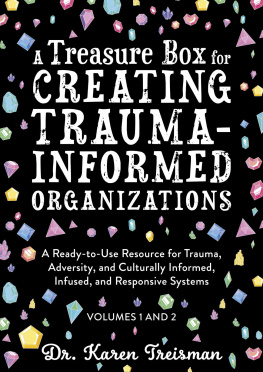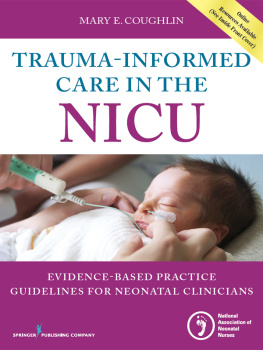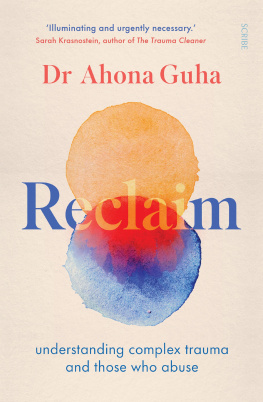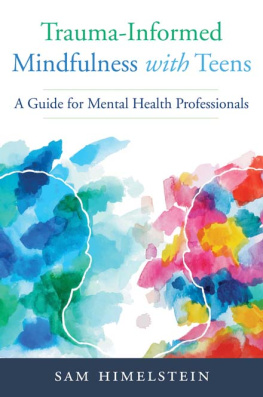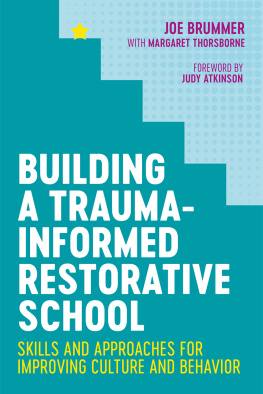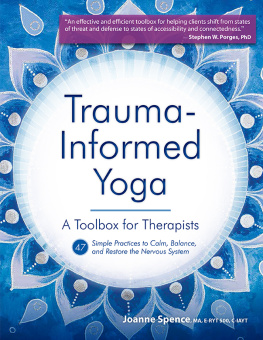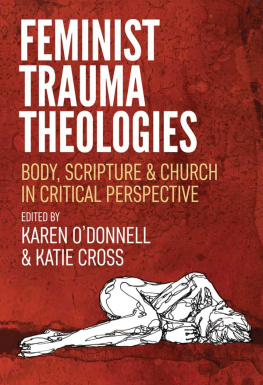Contents


Contents
List of figures
15.7. A collage of photos from my happy place which could be used on a
keyring, a door mat, the front of a diary, as a poster
List of worksheets
Part 1
INDIVIDUAL AND
ORGANIZATIONAL
TRAUMA
What this Means and the
Rationale for Change
All pages marked with can be photocopied and downloaded
at https://library.jkp.com/redeem using the code JTCNAGN
Chapter 1
The Key Elements of Trauma and its Impact
1.1. What this chapter covers
This book primarily focuses on how to interweave ideas about trauma and adversity into the fabric of an organization or system. Therefore, a focus on direct work, the therapeutic intervention side of trauma, and the ins and outs of understanding the process and impacts of trauma are beyond the breadth of this book. It is also hoped that readers pursuing this journey will already have some knowledge around trauma. However, this said, in this chapter, some key elements of trauma are introduced to set the context and to act as a springboard for further discovery. Additionally, different types of trauma such as community, intergenerational, and relational trauma are presented. Following this, some of the associations with trauma, what it is and what it might look like, are shared. The chapter then goes on to discuss factors which contribute to the varying impact of trauma, as well as some of the multi-layered impact of trauma on the body, brain, emotions, relationships, and sensory systems. There is also a section about why the term post-traumatic stress disorder or PTSD is not used throughout this book. To conclude this chapter, there are some box texts which highlight specific groups of people who have experienced trauma, such as pregnant women, those who are homeless, refugees and asylum-seekers, those in the criminal justice and offending population, those in foster, kinship, and residential care, those who have a learning disability, and those from the lesbian, gay, bisexual, transgender, queer, and intersex (LGBTQI) community. Other types of trauma, such as vicarious, secondary, and organizational trauma, are discussed in .
1.2. Definition of trauma and adversity
There are many different definitions of trauma and adversity and lots of varying ideas and opinions around these. The definition used will vary depending on the type of trauma, for example complex versus single-event trauma, community versus cultural trauma, and so on. Therefore, rather than getting caught up in a definitional maze, I will offer a definition below which is often used. However, this book intends to keep the focus on the unique person within their unique context, and on their own meaning-making of the experience they have lived through, not on a reductionist or narrow category.
One definition that is often referred to is that trauma is an event, a series of events, or set of circumstances that is experienced as physically or emotionally harmful or life-threatening, that overwhelms a persons ability to cope, and has lasting adverse effects on their mental, physical, social, emotional, or spiritual wellbeing (National Child Traumatic Stress Network; SAMSHA, 2014).
It is also worth mentioning that the word trauma comes originally from the Greek word traumata , which means to wound, or to pierce. This fits with how trauma can pierce or wound through individual, family, community, and organization layers, and, as expanded in this chapter and the next one, it can be a social, moral, psychological, sensory, and spiritual injury. This is bought to life by Gabor Mate who says, trauma is not an external event but is about an internal wound. He also shares and this will be explored further throughout this book that trauma is not what happens to you but is what happens inside of you.
A word often used in association with trauma is adversity. This is used throughout this book to highlight a range of experiences, including social exclusion and poverty. The noun originally comes from the Latin word adversus , meaning turned against, and figuratively hostile or unfavourable. For example, when things seem against you circumstances, hardships, or challenges you are facing adversity.
This said, whether an event is traumatic depends not just on the event itself, but on our experience, and how we make sense of the trauma, as well as a range of other wider contextual factors. Some of these will be illustrated in the following section.
1.3. Interplaying factors trauma does not occur in a vacuum
Before going on to discuss some of the different types of trauma, and what the implications of these experiences might be, we need to be mindful that trauma does not occur within a vacuum; it is influenced by multiple systemic, relational, cultural, political, and wider contextual elements, and will mean different things to different people and different communities at different times. We need to re-contextualize traumatic and adverse experiences. Therefore, the impact and consequences of trauma vary; they are broad, complex, and multi-layered. The below sketchnote will capture some of these factors (this is by no means an exhaustive or prescriptive list).

1.1. Some of the interplaying factors which can influence the impact of trauma/s
? Take some time to reflect on the above factors and what they mean, what they might look like, and how they might apply to you, and to those whom you support.
? Which factors would you like to add, reword, or change?
1.4. Different types of trauma
Trauma and adversity are umbrella terms. There are numerous different types of traumas and adversities, some of which are illustrated in the infographic below; however, it is by no means an exhaustive or prescriptive list. This infographic is also important as there are many people and organizations who claim (with the best intentions) that they are trauma-informed, but who actually mean that they have learned about one type of trauma, or that they have had some training in one of these areas or that they use certain measures or assessment tools which are designed to assess trauma, but these often only focus on a sub-section of trauma. Therefore, this illustration is intended to give the reader a broader sense of what the different types of trauma might be. This is also key to show the different types of trauma, as often certain aspects of trauma are brought to the fore or spoken about more than others, and within this, the trauma itself is often invisible, missed, camouflaged, or overlooked. Trauma can also often be interlinked with shame, secrecy, avoidance, and silence.
Each of these types of trauma could be the subject of multiple books in their own right, so they are just briefly shared here to raise awareness of them. It is worth mentioning that the reason they are represented as a patchwork in the infographic is that many of them can be interlinked and layered with each other, adding to the intersectionality and complexity. I will not go into the minutia of the academic differences between these different types of trauma, but rather offer a brief introduction to them, and give some examples as to what sorts of experiences these might include in the potential interface with different areas of life such as employment, housing, education, health, and so forth.

